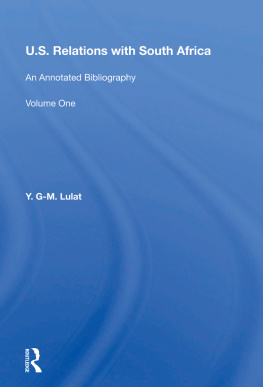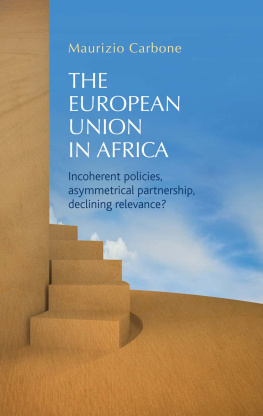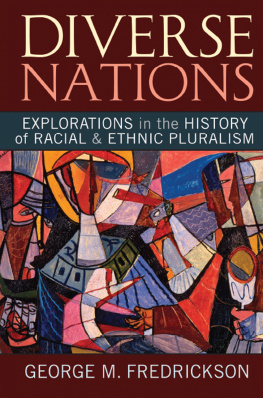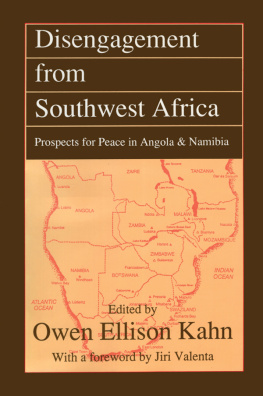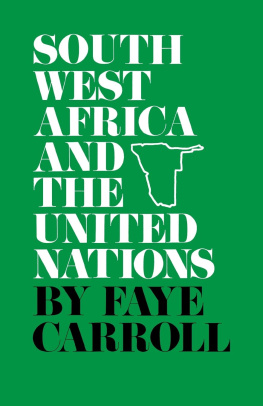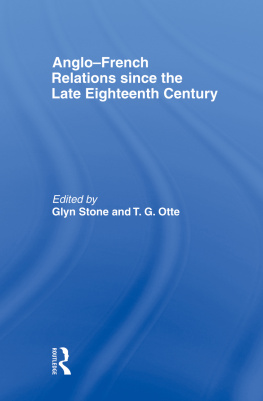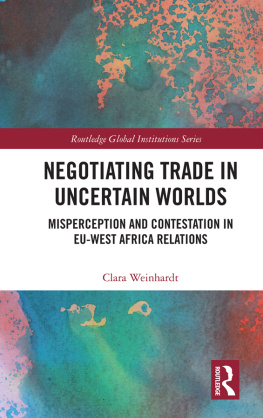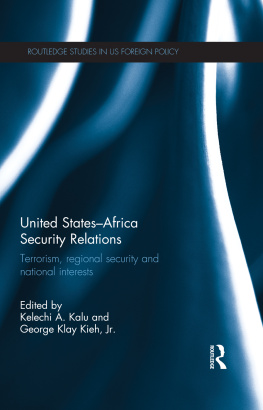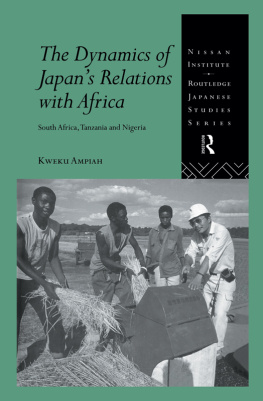U.S. Relations with South Africa
An Annotated Bibliography
Volume One
Books, Documents, Reports, and Monographs
Y. G-M. Lulat
with the assistance of R. V. Guilln,
A. E. Clifford, and F. R. Abosch
First published 1991 by Westview Press
Published 2018 by Routledge
52 Vanderbilt Avenue, New York, NY 10017
2 Park Square, Milton Park, Abingdon, Oxon OX14 4RN
Routledge is an imprint of the Taylor & Francis Group, an informa business
Copyright 1991 by Taylor & Francis
All rights reserved. No part of this book may be reprinted or reproduced or utilised in any form or by any electronic, mechanical, or other means, now known or hereafter invented, including photocopying and recording, or in any information storage or retrieval system, without permission in writing from the publishers.
Notice:
Product or corporate names may be trademarks or registered trademarks, and are used only for identification and explanation without intent to infringe.
Library of Congress Cataloging-in-Publication Data
Lulat, Y. G-M.
U.S. relations with South Africa / an annotated bibliography.
Contents: v. 1. Books, Documents, Reports and Monographs.
v. 2. Periodical literature and guide to sources of current information.
Includes indexes
1. United StatesForeign relationsSouth Africa
Bibliography. 2. South AfricaForeign relations
United StatesBibliography. I. Title. II. Title:
US relations with South Africa.
Z6465.U5L84 1991 [E183.8.S6] 327.73068 86-9094
ISBN 13: 978-0-367-21235-3 (hbk)
On June 26,1990, the world was witness to a remarkable political event: an address to a joint session of the U.S. Congress by a black man in his seventies from South Africa (S.A.); his name: Nelson Mandela. Reporting on the address, the New York Times (June 27, 1990:A11) would observe: "The House chamber is rarely filled for joint meetings receiving visitors, but today was an exception, with even jaded lawmakers reacting as fans in the presence of a celebrity, reaching out to touch Mr. Mandela and, more important, to be photographed with him." He would rouse the predominantly white, and normally staid, Congress to thunderous applause and standing ovation many times during the course of his eloquent speech which he began with the words: "It is a fact of the human condition that it shalllike a meteor, a mere brief passing moment in time and spaceflit across the human stage and pass out of existence And so we have come to Washington in the District of Columbia, and into these hallowed chambers of the United States Congress, not as pretenders to greatness but as a particle of a people whom we know to be noble and heroic, enduring, multiplying, permanent, rejoicing in the expectation and knowledge that their humanity will be reaffirmed and enlarged by open and unfettered communion with the nations of the world."
On the surface, it would appear that Mandela's U.S. visit was simply the logical outcome of one of the most important political developments in S.A.'s recent history: the announcement in South African parliament on February 2, 1990 by the state president, F. W. de Klerk, during his 'state of the union' speech, that his government was immediately lifting its 30-year ban on the ANC. Furthermore, that his government would permit the ANC, the South African Communist Party, the Pan Africanist Congress, and others to become openly active again in S.A.; and that the world's most famous political prisoner, Nelson Mandela, would soon be freed to facilitate negotiations between blacks and whites for a new apartheid-free S.A. based on universal franchise. the end of the world's most odious political system, apartheid, (albeit the actual process would take some years and would be fraught with many obstacles, deceit and betrayals), was itself a product of a series of seemingly unrelated events: they would range from the assassination of John F. Kennedy on November 22, 1963, through the military coup in Lisbon on April 25, 1974, to the Soweto rebellion of June 16, 1976, and on to the passage of the Comprehensive Anti-Apartheid Act of 1986 by the U.S. Congress against the wishes of Ronald Reagan and the defeat of the South African armed forces in Angola in early 1988. The point to note, however, is that one of the key threads weaving together this tapestry of seemingly disparate events scattered across three different continents and through different time periods would be the political and economic role of the U.S. Five years ago, prompted by dissatisfaction with the existing literature on the magnitude, significance and nature of this role, I began a work (now comprising an 800 page volume to be released shortly under the title: Analyzing U.S. Relations with South Africa: Past Present and Future) that sought to document and analyze it within a broad chronological and multi-disciplinary context. This two-volume bibliography is a byproduct of that work.
The bibliography consists of some 4,500 items published over the past one hundred years or so in the English language, sub-divided first by type of material (books, documents, etc.) and further subdivided on the basis of type of annotations (whether full or partial). The inclusion of the partially or unannotated bibliographic sections has been necessitated by space and/or time limitations that did not permit the full annotation of all items deemed worthy of such treatment (such as many of the items published in 1990 and those listed in the addendum). These broad subdivisions (parts) are broken into chapters by subject categories. The final part of volume two (prepared substantially by D. J. Bertuca) is not a bibliographic chapter but a guide to sources of current information designed to assist users to update this bibliography if and when the need arises.
In preparing the annotated bibliography an effort has been made to provide the user with as much information as possible so as to enable the user to arrive at a quick and accurate decision regarding the relevance of a given item for his/her needs. In an age of exploding galaxies of information and knowledge on almost any given topic, bibliographies have to go beyond being simple listings of items if they are to be of any meaningful help to users. Hence, for example, monographic entries provide not only the usual bibliographic information (author, title, publisher, etc.) and synoptic description, but also such other information as the author's institutional affiliation, a listing of the entire contents of the work, and in some cases a listing of places where the work has been reviewed. Since some of the material is now out of print it can only be accessed in libraries. To assist with the location of such material in other libraries, library database identification numbers have also been included where possible. (Note: most users will have to enlist the assistance of the reference librarian a resource person who is at the heart of all public services in a librarywhen using this particular information.) The annotations are nonevaluative so as not to influence the reader for or against a given work.

